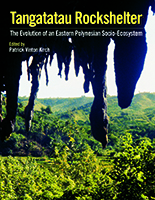Notes
Invertebrate data from Tangatatau Rockshelter (site MAN-44, all units except unit E31).
Item record
Documentation
Invertebrate methods
During the initial 1989 field season, it became apparent that the MAN-44 deposits contained a high density of invertebrate remains, requiring a sampling strategy. It was simply beyond our budget or labor force to recover all of the shell, sea urchin, and crustacean remains, ship these back to the laboratory, and sort and identify the material. During the 1989 excavation, we decided to retain all shell and other invertebrate remains in unit E30 from the ½-in. and ¼-in. mesh sieves but not from the ⅛-in. mesh. As the material in the ⅛-in. mesh sieves was highly fragmented, we felt it would be difficult to identify to genus or species. The invertebrate sample recovered from unit E30 totaled 19.52 kg. We also retained invertebrate remains from unit F10, totaling 1.58 kg.
During the 1991 excavation, we employed a slightly different excavation strategy. For unit E31, we again retained all of the invertebrate remains found in the ½-in. and ¼-in. mesh screens, but this time we also bagged the entire contents of the ⅛-in. mesh, after removing bone, charcoal, and as much of the obvious rock fragments as feasible. The total weight of invertebrate remains recovered from unit E31 totaled 39.87 kg; as both units E30 and E31 had roughly the same volume, the greater weight of invertebrate remains in E31 reflects the additional retention of the contents of ⅛-in. sieves. As the excavation expanded and it became clear that the earliest stratigraphic zones in the MAN-44 sequence were not represented in units E30 or E31, we also retained the invertebrate remains from unit D35, levels 6 (SZ-3) and 7 (SZ-2), totaling 0.85 kg.
Later comparison in the laboratory between the samples recovered from units E30 and E31 demonstrated that the lack of material from the ⅛-in. mesh in unit E30 did not significantly bias the sample in terms of taxonomic representation. All of the genera and species identified for unit E31 were also present in unit E30. The main difference was simply in the addition of a great deal more fragmentary material, which was exceedingly time-consuming to sort and identify. In addition, while only 5 percent of the larger- sized unit E30 material could not be identified down to genus or species, 13 percent of the smaller-sized unit E31 material remained unidentifiable.
The laboratory work of identifying and quantifying the invertebrate remains from MAN-44 was carried out in two phases, by A. Plourde and M. Gonzalez, both as honors thesis research projects at U.C. Berkeley. Plourde analyzed the materials from units C30, D35, and E30 in 1992 (Plourde 1992), while Gonzalez analyzed those from unit E31 in 2014 (Gonzalez 2014).
In the laboratory, invertebrate remains were first sorted into general categories of mollusk, sea urchin, and crustaceans. Mollusk shells were then further sorted to the lowest taxonomic categories possible based on degree of fragmentation; most of the material could be identified at least to genus and much of it to species as well. The high degree of fragmentation of the shell, however, rendered a certain amount of the material unidentifiable beyond the general category “miscellaneous shell.” Assignment of taxonomic names follows Salvat and Rives (1975) in the first instance; Cernohorsky (1971, 1978), Kira (1962), and Habe (1964) were also used as reference guides. Initial taxonomic identifications were confirmed through physical comparison of the MAN-44 specimens with the conchology collection of the Museum of Paleontology at the University of California, Berkeley.
In the analysis of unit E30, Plourde used both weight and NISP, whereas in the quantification of unit E31, Gonzalez also determined MNI in addition to NISP and weight. The criteria used to determine MNI varied according to taxon depending on taphonomic considerations. For example, with the gastropods Nerita and Drupa, MNI was determined on the basis of intact apertures, while with Turbo, the high degree of smashing of the apertures required the counting of intact shell apices.
We have opted to report and analyze the mollusk data by weight. Not only is this the most direct form of quantification, but in fact weight and NISP are highly correlated. Figure 8.1 in the book is a scatterplot and regression of mollusk weight versus NISP for 25 principal taxa from site MAN-44. The very strong correlation between the two measures is confirmed by an R2 value of 0.91. We recognize, of course, that taxa vary considerably in their average shell weights, so that, for example, a heavy Turbo setosus shell weighs considerably more than the two valves of a Modiolus auriculatus. Moreover, edible meat weight does not necessarily correspond to shell weight. This requires caution in making interpretations involving between-taxa comparisons. However, analysis of temporal trends within a site is not affected by these concerns.
In the analysis of the unit E31 mollusk assemblage, Gonzalez also recorded the number of whole or unbroken shells for each taxon and level, permitting the quantification of the degree of fragmentation, as discussed later in this chapter. In addition, burning was noted on a presence/absence basis. The extremely high degree of fragmentation of the MAN-44 mollusk assemblage did not allow us to quantify shell size, except for the case of T. setosus, whose heavy opercula were more resistant to smashing. As operculum diameter is allometrically correlated with shell size, we measured the maximum diameters of all intact T. setosus opercula in an effort to determine whether there is evidence for temporal changes in the size of this important food species. Sea urchin remains were sorted into spines, test fragments, and mouth parts, but only the spines of the distinctive Heterocentrotus mammillatus were identified to species. Similarly, crustacean remains (typically highly fragmented) were separated out as a single category; a representative sample of crustacean remains was examined by Gustav Paulay at the Florida Museum of Natural History.
Reuse
Kirch, Patrick V., 2017. Invertebrate data (site MAN-44). https://doi.org/10.25346/S6/PE6WU5
